Effect of Re-Recycling on Rheology and Microstructure of Asphalt Binder
Abstract
:1. Introduction
- (1)
- Evaluating the evolution of rheological properties of the re-recycled asphalt;
- (2)
- Analyzing the microstructure of re-recycled asphalt binder by FTIR and AFM;
- (3)
- Correlating macro properties and microstructures of the asphalt.
2. Materials and Methods
2.1. Materials and Binder Preparation
2.2. Rheological Properties Test
2.2.1. Viscosity Test
2.2.2. DSR Test
2.2.3. BBR Test
2.3. Microstructure Test
2.3.1. AFM Test
2.3.2. FTIR Test
3. Results and Discussions
3.1. Rheological Properties Analysis
3.1.1. High-Temperature Properties Analysis
3.1.2. Fatigue Performance Analysis
3.1.3. Low-Temperature Performance Analysis
3.2. Microstructure Analysis
3.2.1. AFM Test Analysis
3.2.2. FTIR Test Analysis
3.3. Macro–Micro Correlation
4. Conclusions
- Re-recycling improves the high-temperature performance of asphalt binder; however, it significantly reduces fatigue and low-temperature performance. The aged re-recycled asphalt’s ΔTc ≤ −2.5 °C; the re-recycled asphalt has the risk of low-temperature cracking. ΔTc is an effective index to evaluate the low-temperature performance of re-recycled asphalt.
- Aging accelerates the decay of the rheological properties and significantly increases the microscopic roughness and carbonyl index of re-recycled asphalt. The macro–micro results show that re-recycling significantly reduces the anti-aging performance of asphalt.
- As recycling times increase, the adhesion between asphalt binder and aggregate gradually decreases. Therefore, the re-recycled asphalt mixture has a greater adhesion cracking risk.
- The carbonyl index increases significantly in recycled asphalt binders before and after aging. However, the sulfoxide index has a small change in aged recycled asphalt binders because of sulfur consumption.
- The macroscopic properties are strongly correlated with aging functional groups, roughness, and surface energy of recycled asphalt; aging functional groups also strongly correlate with surface energy and roughness. The microstructural changes in asphalt significantly affect the macroscopic properties.
- All results are based on asphalt experiments; however, the asphalt mixture is also an essential part of recycling, and additional asphalt mixture experiments are crucial. In addition, multiple recycled asphalt preparation method is complex; a simple preparation method is urgently needed.
Author Contributions
Funding
Acknowledgments
Conflicts of Interest
References
- Soares, M.P.; Cerqueira, N.A.; Almeida, F.F.; Azevedo, A.R.; Marvila, M.T. Technical, Environmental, and Economic Advantages in the Use of Asphalt Rubber. In Characterization of Minerals, Metals, and Materials 2021; Springer: Cham, Swizerland, 2021; pp. 577–586. [Google Scholar]
- Vatin, N.I.; Murali, G.; Abid, S.R.; de Azevedo, A.R.; Tayeh, B.A.; Dixit, S. Enhancing the Impact Strength of Prepacked Aggregate Fibrous Concrete Using Asphalt-Coated Aggregates. Materials 2022, 15, 2598. [Google Scholar] [CrossRef]
- Zaumanis, M.; Mallick, R.B.; Frank, R. 100% recycled hot mix asphalt: A review and analysis. Resour. Conserv. Recycl. 2014, 92, 230–245. [Google Scholar] [CrossRef]
- Aurangzeb, Q.; Al-Qadi, I.L.; Ozer, H.; Yang, R. Hybrid life cycle assessment for asphalt mixtures with high RAP content. Resour. Conserv. Recycl. 2014, 83, 77–86. [Google Scholar] [CrossRef]
- Jahanbakhsh, H.; Karimi, M.M.; Naseri, H.; Nejad, F.M. Sustainable asphalt concrete containing high reclaimed asphalt pavements and recycling agents: Performance assessment, cost analysis, and environmental impact. J. Clean. Prod. 2020, 244, 118837. [Google Scholar] [CrossRef]
- Wang, J.; Qin, Y.; Xu, J.; Zeng, W.; Zhang, Y.; Wang, W.; Wang, P. Crack resistance investigation of mixtures with reclaimed SBS modified asphalt pavement using the SCB and DSCT tests. Constr. Build. Mater. 2020, 265, 120365. [Google Scholar] [CrossRef]
- Yoshikane, T. Investigation of Deterioration of Recycled Hot-Mixed Asphalt Concrete Pavement and a Trial re-Recycling of Asphalt Concrete. In Disposal and Recycling of Organic and Polymeric Construction Materials: Proceedings of the International RILEM Workshop; CRC Press: Boca Raton, FL, USA, 1995; pp. 218–229. [Google Scholar]
- Nakanishi, H. Application and Experience of Special Asphalt Mixture in Japan. Korean Soc. Road Eng. 2002, 4, 5–57. [Google Scholar]
- Jie, J.; Shifa, X.; Xiaohui, L. Performance Evaluation of Multiple Recycled Asphalt Mixtures and Warm Mix Asphalt Mixtures; People’s Traffic Press: Beijing, China, 2011; pp. 3–113. [Google Scholar]
- Heneash, U. Effect of the Repeated Recycling on Hot Mix Asphalt Properties. Ph.D. Thesis, University of Nottingham, Nottingham, UK, 2013. [Google Scholar]
- Kriz, P.; Eng, P.; Tardiff, B.J.; Maria, S.R.; Shirts, R.D. Asphalt Re-Recycling; Canadian Technical Asphalt Association: West Kelowna, BC, USA, 2017. [Google Scholar]
- Hugener, M.; Kawakami, A. Simulating repeated recycling of hot mix asphalt. Road Mater. Pavement Des. 2017, 18 (Suppl. 2), 76–90. [Google Scholar] [CrossRef]
- Derossi, L. Experimental Characterization of Bitumen’s Aging Properties; Università Degli Studi Di Padova: Padua, Italy, 2014. [Google Scholar]
- Koudelka, T.; Coufalik, P.; Dasek, O.; Coufalikova, I.; Varaus, M. Rheological characteristics of paving bitumens and recycled binder blends in relation to ageing. Road Mater. Pavement Des. 2021, 22, 1946–1963. [Google Scholar] [CrossRef]
- Nie, Y.; Sun, S.; Ou, Y.; Zhou, C.; Mao, K. Experimental Investigation on Asphalt Binders Ageing Behavior and Rejuvenating Feasibility in Multicycle Repeated Ageing and Recycling. Adv. Mater. Sci. Eng. 2018, 2018, 5129260. [Google Scholar] [CrossRef]
- Antunes, V.; Freire, A.C.; Neves, J. A review on the effect of RAP recycling on bituminous mixtures properties and the viability of multi-recycling. Constr. Build. Mater. 2019, 211, 453–469. [Google Scholar] [CrossRef]
- Zhang, S.; Cui, Y.; Wei, W. Low-temperature characteristics and microstructure of asphalt under complex aging conditions. Constr. Build. Mater. 2021, 303, 124408. [Google Scholar] [CrossRef]
- Marsac, P.; Petiteau, C.; Burban, O.; Terrier, J.P.; Didelet, G.; Demoncheaux, J.; Lorino, T.; Pouget, S. Combined Effect of Warm Mix Processes and Multi-recycling on the Main Criteria of the French Asphalt Mix Design Method. In Proceedings of the 9th International Conference on Maintenance and Rehabilitation of Pavements—Mairepav9; Springer: Cham, Switzerland, 2020; pp. 353–363. [Google Scholar]
- Su, K.; Hachiya, Y.; Maekawa, R. Laboratory Investigation of Possibility of Re-recycling Asphalt concretes. In Proceedings of the 6th ICPT, Sapporo, Japan, 20–23 July 2008. [Google Scholar]
- Wang, D.; Cannone Falchetto, A.; Moon, K.H.; Riccardi, C.; Pei, J.; Wen, Y. Artificially prepared Reclaimed Asphalt Pavement (RAP)—an experimental investigation on re-recycling. Environ. Sci. Pollut. Res. 2019, 26, 35620–35628. [Google Scholar] [CrossRef]
- Anderson, R.M.; King, G.N.; Hanson, D.I.; Blankenship, P.B. Evaluation of the relationship between asphalt binder properties and non-load related cracking. J. Assoc. Asph. Paving Technol. 2011, 80, 615–664. [Google Scholar]
- Koudelka, T.; Coufalik, P.; Fiedler, J.; Coufalikova, I.; Varaus, M.; Yin, F. Rheological evaluation of asphalt blends at multiple rejuvenation and aging cycles. Road Mater. Pavement Des. 2019, 20 (Suppl. 1), S3–S18. [Google Scholar] [CrossRef]
- Das, P.K.; Baaj, H.; Tighe, S.; Kringos, N. Atomic force microscopy to investigate asphalt binders: A state-of-the-art review. Road Mater. Pavement Des. 2016, 17, 693–718. [Google Scholar] [CrossRef]
- Blom, J.; Soenen, H.; Van den Brande, N. New evidence on the origin of ‘bee structures’ on bitumen and oils, by atomic force microscopy (AFM) and confocal laser scanning microscopy (CLSM). Fuel 2021, 303, 121265. [Google Scholar] [CrossRef]
- Santos, S.D.; Partl, M.N.; Poulikakos, L.D. Newly observed effects of water on the microstructures of bitumen surface. Constr. Build. Mater. 2014, 71, 618–627. [Google Scholar] [CrossRef]
- Zhang, H.; Wang, Y.; Yu, T.; Liu, Z. Microstructural characteristics of differently aged asphalt samples based on atomic force microscopy (AFM). Constr. Build. Mater. 2020, 255, 119388. [Google Scholar] [CrossRef]
- Pauli, T.; Grimes, W.; Beiswenger, J.; Schmets, A.J.M. Surface structuring of wax in complex media. J. Mater. Civ. Eng. 2015, 27, C4014001. [Google Scholar] [CrossRef]
- Lu, X.; Sjövall, P.; Soenen, H.; Blom, J.; Makowska, M. Oxidative aging of bitumen: A structural and chemical investigation. Road Mater. Pavement Des. 2021, 23, 1091–1106. [Google Scholar] [CrossRef]
- Lin, M.; Shuai, J.; Li, P.; Kang, X.; Lei, Y. Analysis of rheological properties and micro-mechanism of aged and reclaimed asphalt based on multi-scales. Constr. Build. Mater. 2022, 321, 126290. [Google Scholar] [CrossRef]
- Chang, R.; Yan, E.; Xu, J.; Wang, G. Investigation of the Calculation Modeling of Asphalt Binder Surface Energy Based on the Atomic Force Microscope (AFM). In RILEM 252-CMB-Symposium on Chemo Mechanical Characterization of Bituminous Materials; Springer: Cham, Switzerland, 2018; pp. 236–241. [Google Scholar]
- Abdelaziz, A.; Masad, E.; Martin, A.E.; Mercado, E.A.; Bajaj, A. Multiscale characterization of aging and rejuvenation in asphalt binder blends with high RAP contents. J. Mater. Civ. Eng. 2021, 33, 04021287. [Google Scholar] [CrossRef]
- He, H.; Zhang, E.; Fatokoun, S.; Shan, L. Effect of the softer binder on the performance of repeated RAP binder. Constr. Build. Mater. 2018, 178, 280–287. [Google Scholar] [CrossRef]
- Cong, P.; Guo, X.; Mei, L. Investigation on rejuvenation methods of aged SBS modified asphalt binder. Fuel 2020, 279, 118556. [Google Scholar] [CrossRef]
- Cong, P.; Luo, W.; Xu, P.; Zhao, H. Investigation on recycling of SBS modified asphalt binders containing fresh asphalt and rejuvenating agents. Constr. Build. Mater. 2015, 91, 225–231. [Google Scholar] [CrossRef]
- Jing, R.; Varveri, A.; Liu, X.; Scarpas, A.; Erkens, S. Ageing effect on chemo-mechanics of bitumen. Road Mater. Pavement Des. 2021, 22, 1044–1059. [Google Scholar] [CrossRef]
- Wang, H.; Liu, X.; Apostolidis, P.; Van De Ven, M.; Erkens, S.; Skarpas, A. Effect of laboratory aging on chemistry and rheology of crumb rubber modified bitumen. Mater. Struct. 2020, 53, 1–15. [Google Scholar] [CrossRef]
- Zhou, T.; Cao, L.; Fini, E.H.; Li, L.; Liu, Z.; Dong, Z. Behaviors of asphalt under certain aging levels and effects of rejuvenation. Constr. Build. Mater. 2020, 249, 118748. [Google Scholar] [CrossRef]
- Ge, D.; Chen, S.; You, Z.; Yang, X.; Yao, H.; Ye, M.; Yap, Y.K. Correlation of DSR results and FTIR’s carbonyl and sulfoxide indexes: Effect of aging temperature on asphalt rheology. J. Mater. Civ. Eng. 2019, 31, 4019115. [Google Scholar] [CrossRef]
- Petersen, J.C.; Glaser, R. Asphalt oxidation mechanisms and the role of oxidation products on age hardening revisited. Road Mater. Pavement Des. 2011, 12, 795–819. [Google Scholar] [CrossRef]
- Mullapudi, R.S.; Sudhakar Reddy, K. Relationship between rheological properties of RAP binders and cohesive surface free energy. J. Mater. Civ. Eng. 2020, 32, 04020137. [Google Scholar] [CrossRef]
- Wei, J.; Zhang, Y. Influence of aging on surface free energy of asphalt binder. Int. J. Pavement Res. Technol. 2010, 3, 343. [Google Scholar]
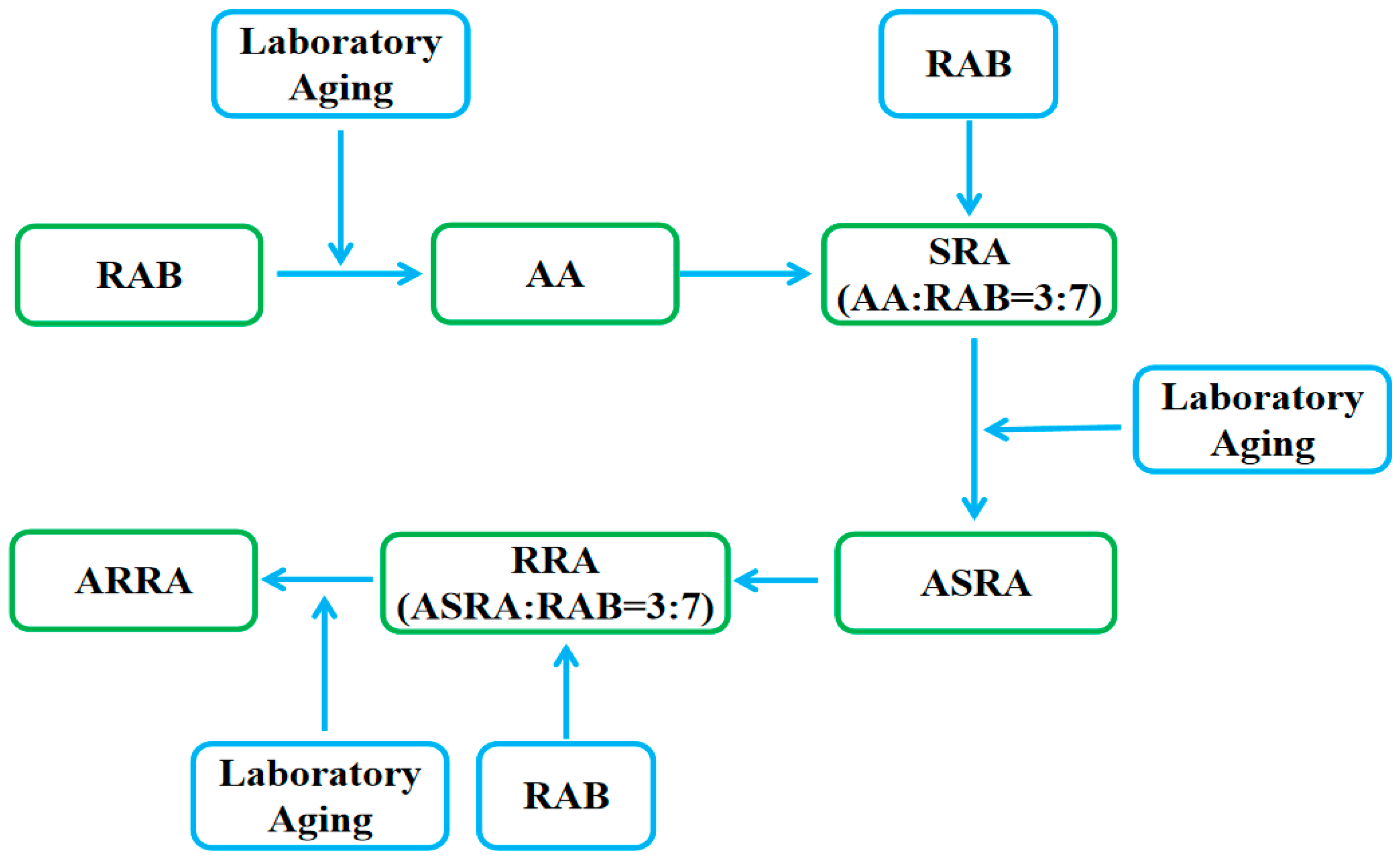

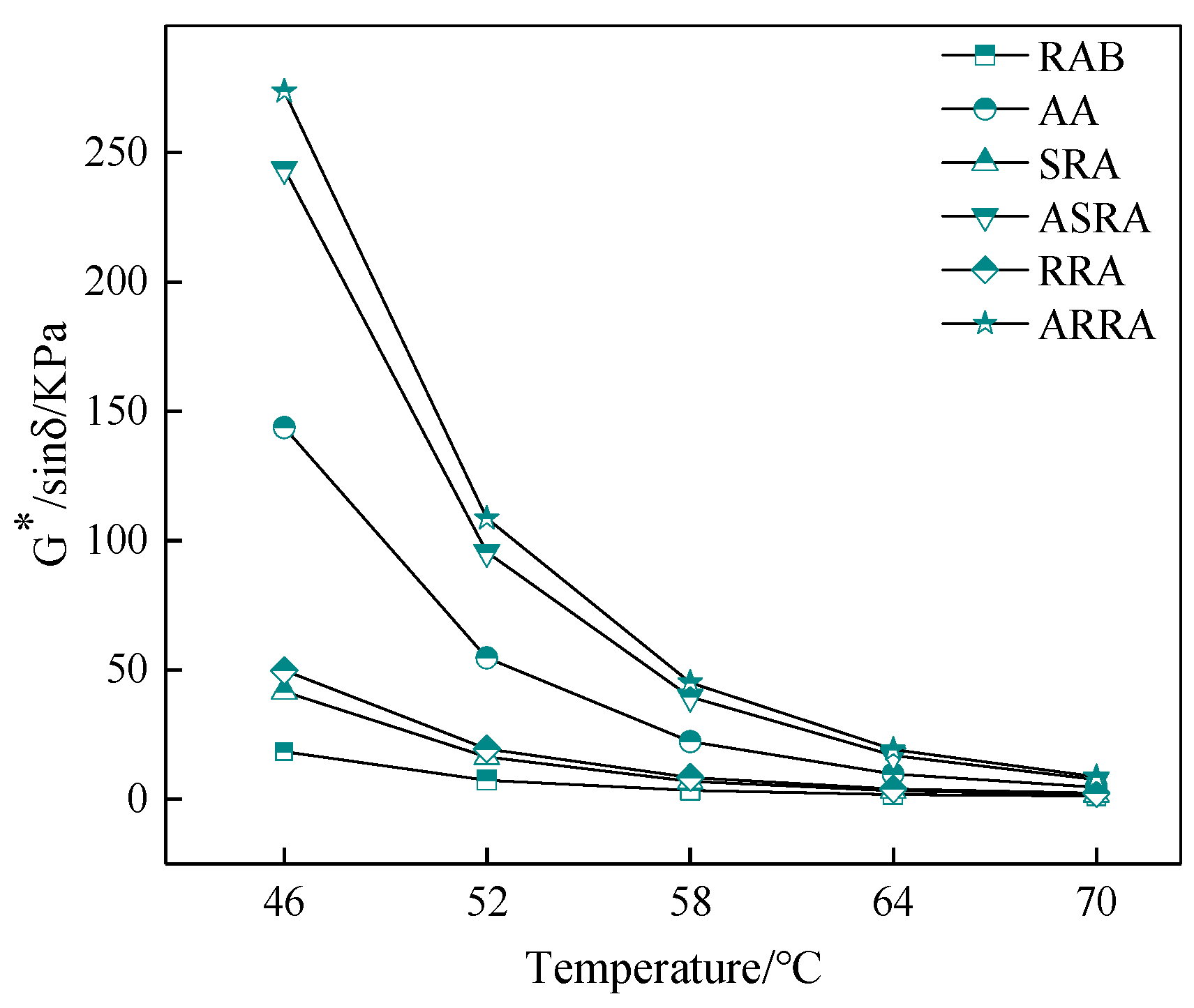


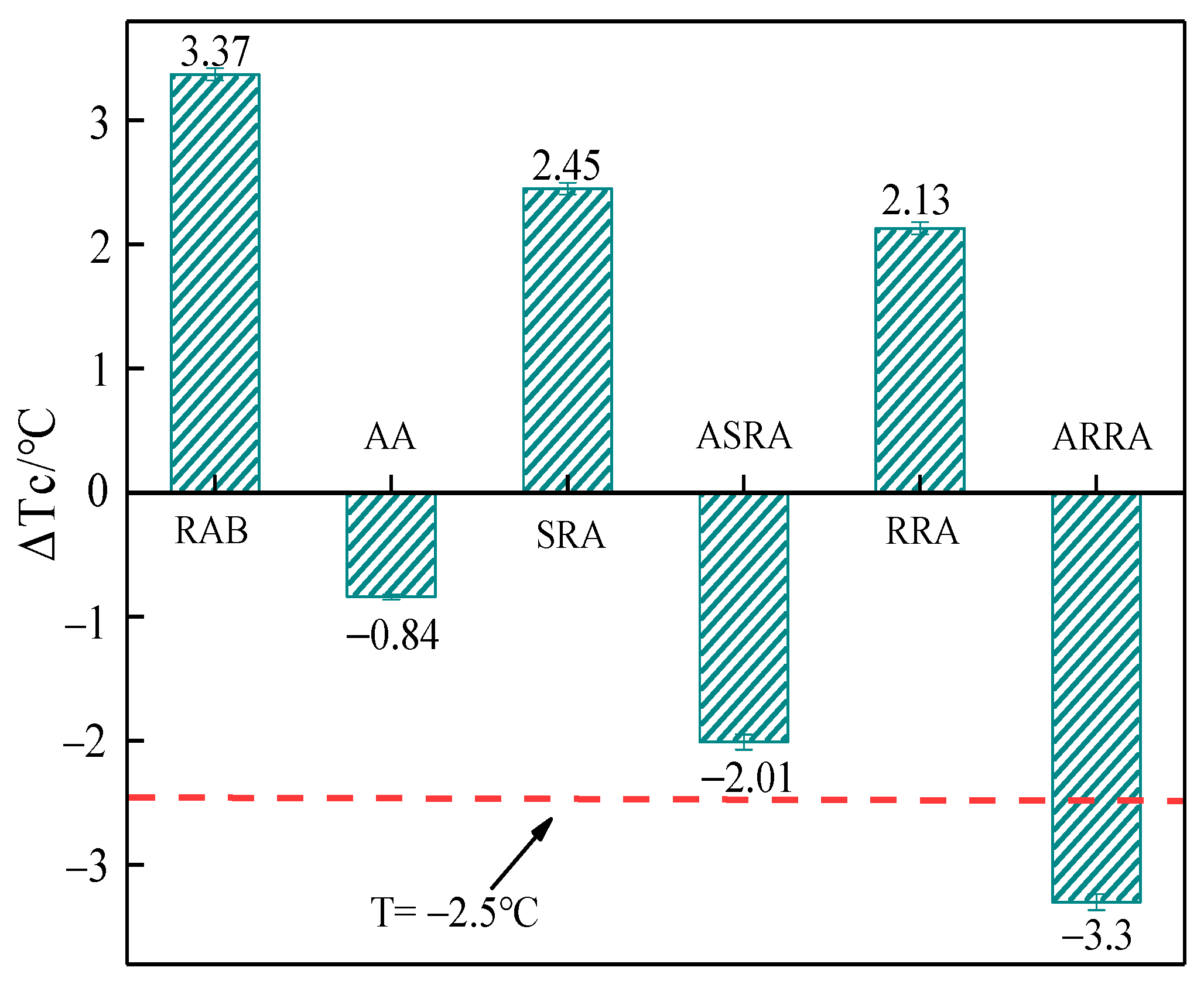

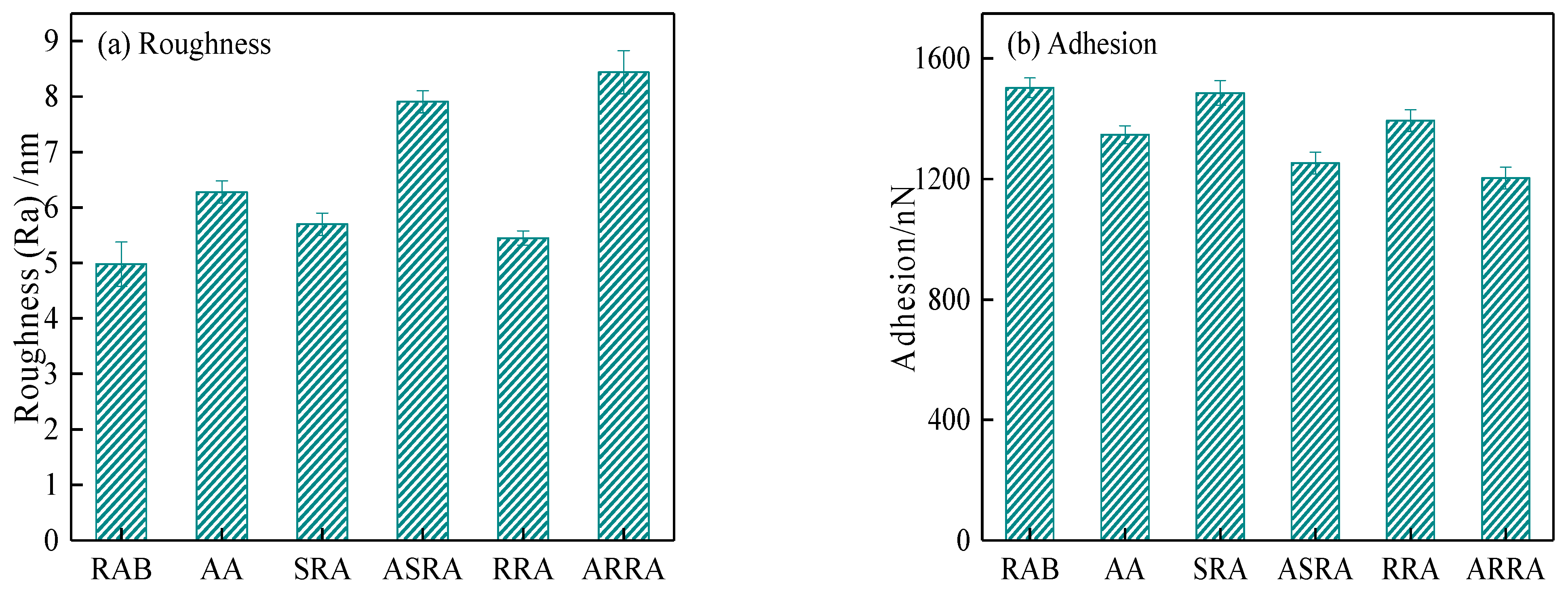
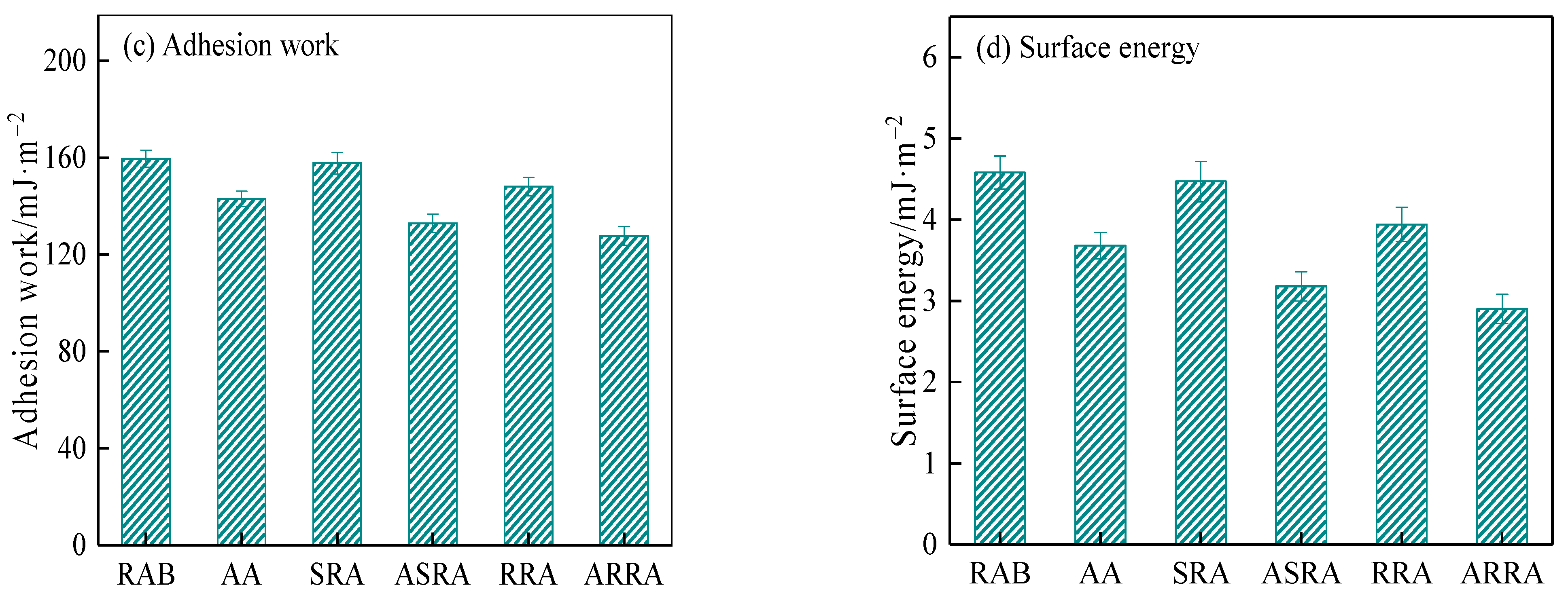
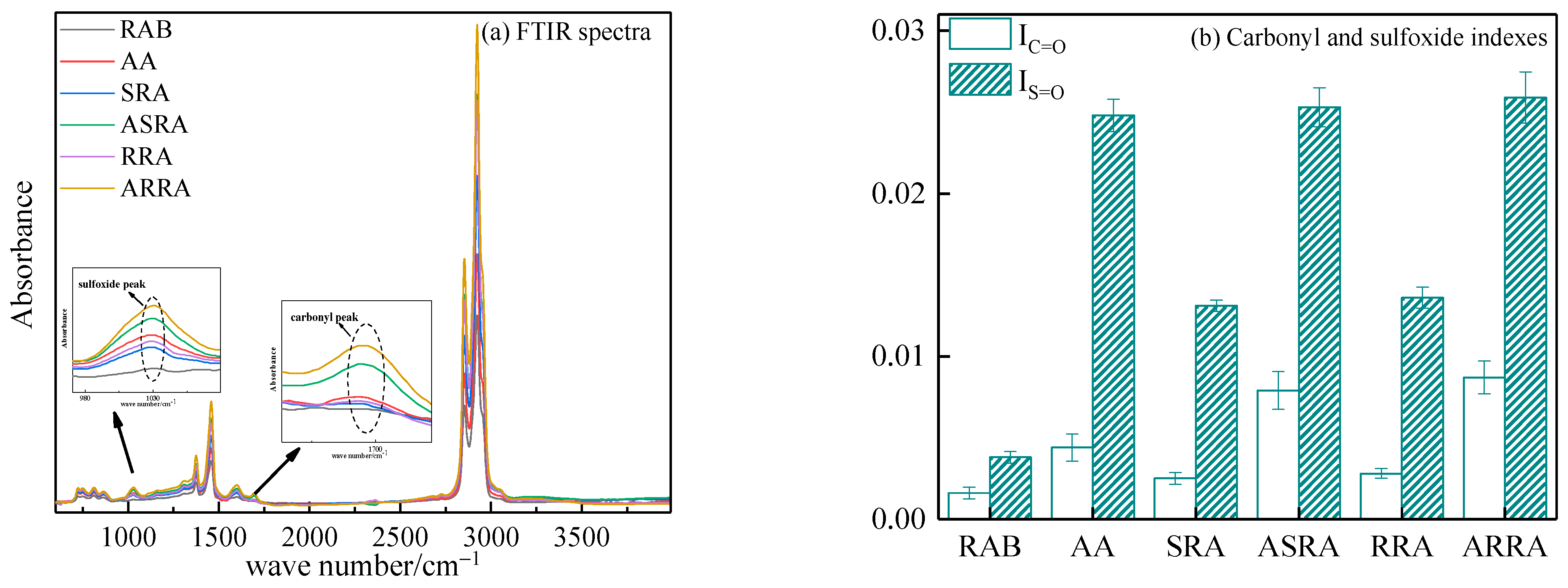
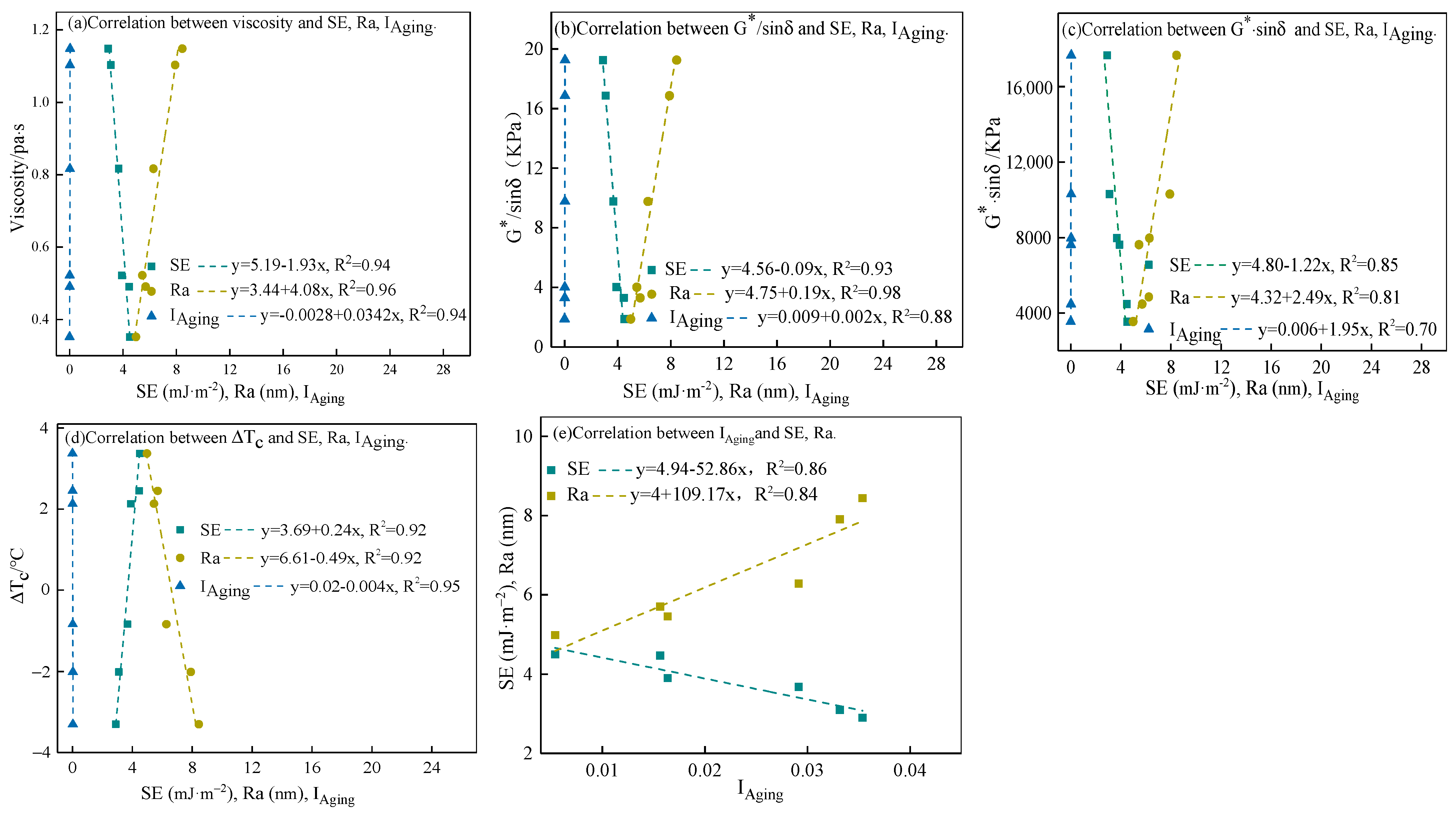
| Technical Index | Results |
|---|---|
| Penetration Value/0.1 mm | 77.76 |
| Softening Point/°C | 47.85 |
| Ductility at 10 °C/cm | >100 |
| Number | Sample ID | Description |
|---|---|---|
| 1 | TFOT | Thin-film oven test |
| 2 | PAV | Pressure aging vessel |
| 3 | RAB | Raw asphalt binder |
| 4 | AA | Aged raw asphalt binder |
| 5 | SRA | Single recycled asphalt binder |
| 6 | ASRA | Aged single recycled asphalt binder |
| 7 | RRA | Re-recycled asphalt binder |
| 8 | ARRA | Aged re-recycled asphalt binder |
Publisher’s Note: MDPI stays neutral with regard to jurisdictional claims in published maps and institutional affiliations. |
© 2022 by the authors. Licensee MDPI, Basel, Switzerland. This article is an open access article distributed under the terms and conditions of the Creative Commons Attribution (CC BY) license (https://creativecommons.org/licenses/by/4.0/).
Share and Cite
Chen, R.; Zhu, H.; Ou, L.; Xu, Y. Effect of Re-Recycling on Rheology and Microstructure of Asphalt Binder. Materials 2022, 15, 6641. https://doi.org/10.3390/ma15196641
Chen R, Zhu H, Ou L, Xu Y. Effect of Re-Recycling on Rheology and Microstructure of Asphalt Binder. Materials. 2022; 15(19):6641. https://doi.org/10.3390/ma15196641
Chicago/Turabian StyleChen, Ruipu, Hongzhou Zhu, Li Ou, and Yanling Xu. 2022. "Effect of Re-Recycling on Rheology and Microstructure of Asphalt Binder" Materials 15, no. 19: 6641. https://doi.org/10.3390/ma15196641




